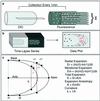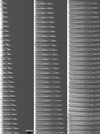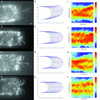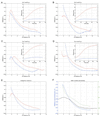Cell surface expansion in polarly growing root hairs of Medicago truncatula
- PMID: 11080274
- PMCID: PMC59196
- DOI: 10.1104/pp.124.3.959
Cell surface expansion in polarly growing root hairs of Medicago truncatula
Abstract
Fluorescent microspheres were used as material markers to investigate the relative rates of cell surface expansion at the growing tips of Medicago truncatula root hairs. From the analysis of tip shape and microsphere movements, we propose three characteristic zones of expansion in growing root hairs. The center of the apical dome is an area of 1- to 2- microm diameter with relatively constant curvature and high growth rate. Distal to the apex is a more rapidly expanding region 1 to 2 microm in width exhibiting constant surges of off-axis growth. This middle region forms an annulus of maximum growth rate and is visible as an area of accentuated curvature in the tip profile. The remainder of the apical dome is characterized by strong radial expansion anisotropy where the meridional rate of expansion falls below the radial expansion rate. Data also suggest possible meridional contraction at the juncture between the apical dome and the cell body. The cell cylinder distal to the tip expands slightly over time, but only around the circumference. These data for surface expansion in the legume root hair provide new insight into the mechanism of tip growth and the morphogenesis of the root hair.
Figures






Similar articles
-
The mechanics of surface expansion anisotropy in Medicago truncatula root hairs.Plant Physiol. 2004 Oct;136(2):3266-75. doi: 10.1104/pp.104.043752. Epub 2004 Sep 24. Plant Physiol. 2004. PMID: 15448192 Free PMC article.
-
Endoplasmic microtubules configure the subapical cytoplasm and are required for fast growth of Medicago truncatula root hairs.Plant Physiol. 2002 Oct;130(2):977-88. doi: 10.1104/pp.004267. Plant Physiol. 2002. PMID: 12376661 Free PMC article.
-
Texture of cellulose microfibrils of root hair cell walls of Arabidopsis thaliana, Medicago truncatula, and Vicia sativa.J Microsc. 2012 Jul;247(1):60-7. doi: 10.1111/j.1365-2818.2012.03611.x. Epub 2012 Mar 28. J Microsc. 2012. PMID: 22458271
-
Microtubules guide root hair tip growth.New Phytol. 2005 Sep;167(3):711-9. doi: 10.1111/j.1469-8137.2005.01506.x. New Phytol. 2005. PMID: 16101908 Review.
-
Building a hair: tip growth in Arabidopsis thaliana root hairs.Philos Trans R Soc Lond B Biol Sci. 2002 Jun 29;357(1422):815-21. doi: 10.1098/rstb.2002.1092. Philos Trans R Soc Lond B Biol Sci. 2002. PMID: 12079677 Free PMC article. Review.
Cited by
-
The mechanics of surface expansion anisotropy in Medicago truncatula root hairs.Plant Physiol. 2004 Oct;136(2):3266-75. doi: 10.1104/pp.104.043752. Epub 2004 Sep 24. Plant Physiol. 2004. PMID: 15448192 Free PMC article.
-
Infection and invasion of roots by symbiotic, nitrogen-fixing rhizobia during nodulation of temperate legumes.Microbiol Mol Biol Rev. 2004 Jun;68(2):280-300. doi: 10.1128/MMBR.68.2.280-300.2004. Microbiol Mol Biol Rev. 2004. PMID: 15187185 Free PMC article. Review.
-
Pollen tube growth: coping with mechanical obstacles involves the cytoskeleton.Planta. 2007 Jul;226(2):405-16. doi: 10.1007/s00425-007-0491-5. Epub 2007 Feb 22. Planta. 2007. PMID: 17318608
-
An actin mechanostat ensures hyphal tip sharpness in Phytophthora infestans to achieve host penetration.Sci Adv. 2022 Jun 10;8(23):eabo0875. doi: 10.1126/sciadv.abo0875. Epub 2022 Jun 10. Sci Adv. 2022. PMID: 35687685 Free PMC article.
-
Pollen tube growth oscillations and intracellular calcium levels are reversibly modulated by actin polymerization.Plant Physiol. 2008 Apr;146(4):1611-21. doi: 10.1104/pp.107.113035. Epub 2008 Feb 8. Plant Physiol. 2008. PMID: 18263780 Free PMC article.
References
-
- Arioli T, Peng L, Betzner AS, Burn J, Wittke W, Herth W, Camilleri C, Hofte H, Plazanski J, Birch R, Cork A, Glover J, Redmond J, Williamson RE. Molecular analysis of cellulose biosynthesis in Arabidopsis. Science. 1998;279:717–720. - PubMed
-
- Bartnicki-Garcia S, Bartnicki DD, Gierz G. Determinants of fungal cell wall morphology: the vesicle supply center. Can J Bot. 1995;73:S372–S378.
-
- Bibikova T, Zhigilei A, Gilroy S. Root hair growth in Arabidopsis thaliana is directed by calcium and an endogenous polarity. Planta. 1997;203:495–505. - PubMed
-
- Carpita NC, Gibeaut DM. Structural models of primary cell walls in flowering plants: consistency of molecular structure with the physical properties of the cell during growth. Plant J. 1993;3:1–30. - PubMed
Publication types
MeSH terms
LinkOut - more resources
Full Text Sources
Miscellaneous

